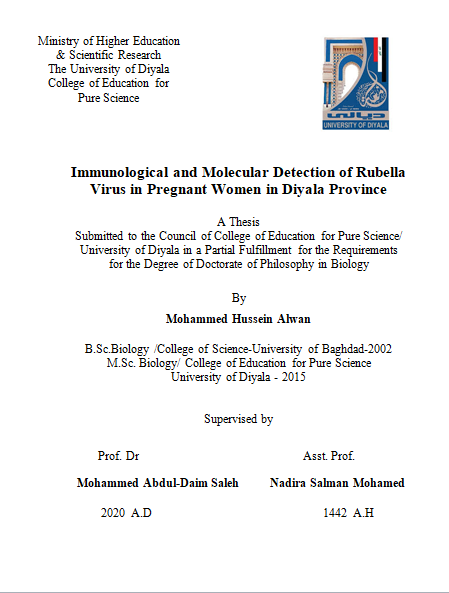Summary
Rubella is caused by an RNA virus in the Rubivirus genus and the Togaviridae family. Popular clinical symptoms involve fever, rash, cough, lymphadenopathy, and often arthritis. While most infections with rubella cause mild, self-limiting measles-like disease, the real danger occurs when the fetus is infected with the rubella virus. As the virus may attack any portion of the growing fetus, any organ may be damaged, this number of congenital malformations known as congenital rubella syndrome, may involve the brain, heart, hearing, and vision
This study was intended to determine rubella virus seroprevalence and molecular detection of virus in pregnant women. The samples included 240 women who were attended during the period from October 2018 to May 2020 to Al-Batool Teaching Hospital for maternally and children in Baqubah-Diyala province.
Women's age ranged from 16-45 years; their age mean was 26.38± 5.11 years. Data collection included age, education, number of previous abortions, gestational age, and residence. Sera were collected from blood of each woman, and the antirubella IgG, IgM were detected by using Electrochemiluminescence , ELISA, On Site Rubella IgG/IgM Rapid tests and RT-rPCR assay were used to detect rubella viral RNA. The results revealed that anti-rubella IgG antibodies for the 240 pregnant women were ranged from (203+ve) 84.58% to (215+ve) 89.58% depending on the method employed. While the anti-rubella IgM antibodies for the 240 pregnant women ranges from (12+ve) 5% to (13+ve) 5.41% depending on the used method. Only 8 from 240 serum specimens of pregnant women were positive for rubella viral RNA with (3.33%) by RT-rPCR test.
This study revealed that the lowest rate of IgG seopositivity was at the age group of 15-20 years, while the highest rate was at an older age group of <32 years. Also the study revealed that the rate of IgG seropositivity was higher (92.13%) among women who live in the urban areas while represent (82.30%) among women who live in the rural areas with significant relation (P< 0.05). In regard to the history of abortion, the IgG seropositivity were (61.42%) of pregnant women who had history of abortion with significant relation (P< 0.05), however the recurrent abortion among pregnant women have the past of one or more abortions with insignificant difference (P>0.05).
There was no significant association between seropositivity of rubella and level of education and trimesters of gestation. Molecular detection of viral infection were done by using revers transcription real-time PCR (RT-rPCR). Rubella positive RT-rPCR samples were selected for genotyping of PCR products depending on the E1 gene amplified by RT-nPCR. Three samples of eight was positive by RT-rPCR test was produced bands sized 719bp by using RT-nPCR by the second pair of primers depending on primers amplification flanking region of genotype 1E, and two tested samples were produced bands sized 219-271 bp by using RT-nPCR by the third pair of primers indicated 2B genotype.





